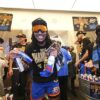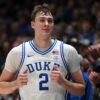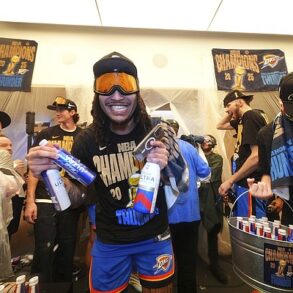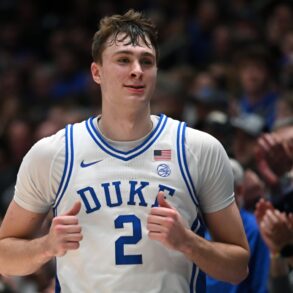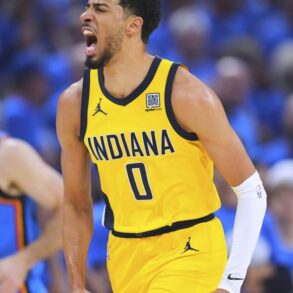The Indiana Pacers woke up Sunday morning one victory away from their first NBA championship. They were much further away from their first championship by the end of Sunday night. They didn’t just lose Game 7 against the Oklahoma City Thunder on Sunday. They lost Tyrese Haliburton, the 25-year-old superstar who makes their entire playing style possible, to a lower leg injury that is widely believed to be a torn Achilles tendon.
The best-case scenario on a torn Achilles is a lost season. Things only get bleaker from there. This injury can ruin careers. Speed is an essential component of Haliburton’s game. We have no idea what sort of player he’s going to be when he returns. The Pacers directly missed out on a chance to win the 2025 championship because of this injury. They’ll almost certainly miss out on 2026 as well without him, and who knows what happens after that. When you consider that this literally happened in the season’s final game, you’d be hard-pressed to find many more devastating injuries in all of NBA history.
Or, for that matter, any injuries that are more consequential. This is an exceedingly young Indiana team that may not have peaked yet. It just lost to a Thunder team trying to launch a dynasty. OKC’s trajectory may have been inexorably altered by Haliburton’s injury. The Eastern Conference was already looking wide open in the wake of another Achilles injury, the one suffered by Jayson Tatum in the second round against the New York Knicks. There are ripple effects here that are going to impact the entire rest of the league.
So let’s try to figure out what they’re going to be. We’ll start with the Pacers and slowly make our way out to the rest of the NBA.
So… where do the Pacers go from here?
On Tuesday, the Pacers made a trade that seemed somewhat innocuous at the time. They traded their 2025 first-round pick, No. 23 overall, to the New Orleans Pelicans for their own 2026 first-round pick, which they gave up in the Pascal Siakam trade and the Pelicans acquired in their subsequent Brandon Ingram deal. The trade was probably meant just to save tax dollars next season and duck the Stepien Rule in case the Pacers ever wanted to trade meaningful draft capital again in the near future.
But now? This trade looks absolutely critical, as the Pacers control their first-round pick in a season that they will likely play without their best player. That doesn’t mean Indiana is going to tank. Frankly, the Pacers never do that. They’ve missed the playoffs in just nine of the past 37 seasons. But their short- and long-term trajectory has changed significantly with this one injury. They may not be terrible, but they’re no longer in the championship picture, and in a world in which the Play-In Tournament has produced back-to-back lottery winners, control over their pick feels pretty valuable. Just how valuable depends on what happens to their roster.
The obvious questions here start with impending free agent Myles Turner. By all accounts, the Pacers planned to go into the luxury tax to retain him. Indiana hasn’t paid the tax in 20 years. This has been one of the NBA’s thriftiest teams for decades now. Paying the tax, even just crossing the line without incurring apron restrictions or repeater penalties, is no small thing in that market. They might even have been counting on the revenue that comes from a deep playoff run to offset the cost overruns that come with doing so. It’s entirely possible that Indiana reconsiders its position in light of Haliburton’s injury.
That doesn’t mean Turner would necessarily leave. The Nets are the only team that currently has the cap space to chase him anyway, unless the Pistons, rumored to be interested, do a bit of work to clear out money. More likely, the Pacers would shed a salary in order to keep him. Even that is precarious for their on-court ambitions.
Everyone the Pacers pay is good. You’re not just going to give Obi Toppin away after the postseason he just had. If there’s a logical player to move here — and, in basketball terms, there explicitly is not — it would be Finals hero T.J. McConnell. This was his age-33 season. He’ll be 35 when Haliburton gets back. Someone would probably give up meaningful draft capital to get him this summer, and he fits snugly into the non-taxpayer mid-level exception. It would be a pretty deplorable showing of greed to move someone that beloved and valuable to the team just to save money, but we can’t pretend it’s off the table entirely.
No matter the budget, the Pacers have to consider where their backcourt stands. They still have McConnell for the moment, but he’s a relatively low-minutes player. Andrew Nembhard is locked into a team-friendly extension, and Bennedict Mathurin is now probably headed for a bigger role. He’ll likely start next season with Nembhard at point guard, and conveniently enough, he’s eligible for a rookie extension. The Pacers have historically locked players up early when possible, and getting Mathurin signed before a possible breakout, higher-usage campaign is important.
But the three of them are not going to be enough to get the Pacers through the season given Indiana’s breakneck pace. The Pacers are going to have to find another guard somewhere. Their spending power is going to be significant here, because, again, everyone they currently pay is good. It doesn’t make sense long-term to trade a valuable frontcourt player just to fill in for Haliburton. The correct basketball move would be to use the taxpayer mid-level exception on a point guard. Either of the Jones brothers, Tyus or Tre, make sense as low-rent versions of Haliburton in that they never turn the ball over and emphasize ball-movement. Neither is anywhere near as electric as Haliburton in transition or close to his equal as a shooter, but they’re useful stopgaps.
If money is a concern and they only have the minimum to offer? Things get harder. They’re in Indiana and they’re no longer immediate championship contenders. Their recruiting appeal is going to be limited. Their hope would have to be a situation similar to Gary Trent Jr. last season: someone good gets squeezed out of fair money by the market and emphasizes role. Rick Carlisle puts his backup guards in a position to succeed. He’s the most desirable thing the Pacers can sell right now.
But realistically, the championship pursuit is on hold. The Pacers will try to stay afloat for a year, and once they’ve seen where they are when Haliburton is closer to returning, they can start to consider what bigger-picture changes are needed. For now, the goal will be keeping the team together, convincing ownership to pay everyone and managing the fringes.
What does this championship mean for the Thunder?
There’s no such thing as an asterisk championship. Or, perhaps more appropriately, every championship is an asterisk championship. Boston didn’t face a single healthy team in the Eastern Conference last postseason. Denver didn’t face a 50-win team in its championship run. You can poke holes in any championship. The Thunder’s, frankly, are smaller than most.
But you pay a price for winning that way, and it goes beyond the reputational hit you take among fans. The real loss is clarity. The Thunder reached the mountaintop, but it’s not as though they were flawless in getting there. Every perceived weakness this team had coming into the postseason presented itself in significant ways. They didn’t have a second, reliable shot-creator. Their 3-point shooting was suspect against playoff-level defenses. They did make big mistakes late in close games, owing perhaps in part to their experience. They overcame all of those issues, but they easily could’ve lost the championship as a result.
Why Thunder are perfectly set up to be next NBA dynasty after winning first championship in OKC
Sam Quinn
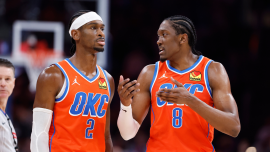
It would be unfair to save they overcome those vulnerabilities because of Haliburton’s injury. We have no idea what would have happened if he’d been able to play the whole game, and even if they’d lost, the Thunder are not the sort of team to make major changes based on a single game. But there’s real value in seeing how your team holds up in such severe conditions. Maybe the Thunder would have learned something about themselves in a closer game against the full-strength Pacers. Maybe there was something they were supposed to learn but didn’t because of the way they won. The same could arguably be said about the Denver series, which ended with an injured Aaron Gordon.
We like to pretend that each, individual championship happens in a vacuum. They don’t. What happens in one season feeds into the next, and that creates all manner of interesting hypotheticals here. If the Thunder had indeed lost at home to a healthy Haliburton, would that have shaken their confidence in tight playoff games next season? Are they theoretically better equipped to win now moving forward because they’ve gotten the first championship monkey off of their backs? They’re certainly more experienced now. They’ll enter next season as the favorites.
The first championship is the launching pad championship. Generally speaking, that’s the roster you move forward with. These are probably the Thunder moving forward, aside from the necessary salary-related moves they’ll have to make moving forward. In a way, that’s probably a bit better for the rest of the league. The last thing anyone wanted was a desperate, aggressive Sam Presti adding talent this offseason. They took a bizarre path to getting hurt, but the outcome is what we expected coming into the playoffs. The Thunder are the champions. They have their team. They have a real chance to win more of them moving forward. It’s just a bummer that any of that happened with any sort of asterisk attached, even if it was a smaller one than most. We’ll never quite know how the Thunder would have reacted to the healthy version of this game, both within it and beyond.
How does the Eastern Conference respond here?
After the second round, the Eastern Conference throne was seemingly vacant. Tatum’s injury effectively closed Boston’s short-term window, which subsequently opened several more. New York fired Tom Thibodeau out of fear of wasting the opportunity Boston’s absence created. Orlando traded for Desmond Bane. But as the Finals progressed and it became clearer and clearer that Indiana’s ascent was no fluke, the excitement over the wide-open Eastern Conference subsided. Maybe the Pacers had just picked up where the Celtics left off.
But now that the Pacers are out too? Well, now it’s game on. If any one team is kicking itself right now, it’s probably the Phoenix Suns. Might some of those Eastern Conference suitors for Kevin Durant have put more on the table with the Pacers out of the way? The Miami Heat and Toronto Raptors have to be wondering what might have been rigght about now.
Of course, trade season isn’t over. Suddenly, a whole bunch of teams have to stop and rethink whatever they were planning for the next few weeks. The Philadelphia 76ers have the No. 3 overall pick in Wednesday’s NBA Draft. By all indications, they planned to either use it or move down a few slots. That made plenty of sense. The 76ers can’t rely on good health out of Joel Embiid or Paul George anymore. Why not reorient the roster around Tyrese Maxey‘s timeline? Well, because the East will probably be good again by the time any top-three pick develops. A trip to the Finals is seemingly available now. Would they consider trading that pick for veteran help? How about some of the conference’s younger teams? Do the Detroit Pistons have a Bane-esque move in them? How about the Atlanta Hawks? Is there some other star the Heat or Raptors can trade for?
Or maybe we’re overlooking an obvious favorite. Maybe the 64-win Cavaliers could have beaten the Pacers with better health and now stand as the clear frontrunner. They have second apron issues to address, but if they’re willing to pay a huge tax bill they can keep most of this team together. Or maybe one of the many, many employed head coaches the Knicks have tried to steal finds a way to wriggle free solely to pursue the opportunity newly at hand here. Opportunities like this are rare. Someone is going to try to seize it.
What does the NBA at large learn from this?
I’d love to tell you that the NBA is going to take some sort of meaningful step to protect the health of its players. Statistically speaking, playoff injuries are more common than ever. We’d already broken the record for most Achilles tears in a season even before Haliburton went down. The sport is clearly changing. Basketball is more physically demanding today than it’s ever been. It asks more of human muscles and joints that just can’t evolve at the pace that the sport does. The league probably needs to change in some meaningful way to address this.
But the only obvious remedy here would be to cut the number of games and give teams more rest. There’s frankly too much money on the line for anyone—owners or players—to agree to that. It would probably be in the best long-term interest of the sport. It is not in the best short-term financial interest of the people making those decisions. Significant changes on a league-wide scale probably aren’t coming.
On a team-wide scale, though, the treatment of calf injuries probably has to be under scrutiny. Remember, Kevin Durant suffered his own Achilles tear under similar circumstances, playing through a calf strain in the NBA Finals. Medical staffs might need to be more cautious with calves moving forward, protecting players from themselves by keeping them out far longer than they currently are. As badly as players want to come back, the risk might outweigh the reward at this point.
And then there are the roster-building implications here. Think of how many teams reportedly kept their best assets off of the table for Durant. There’s a common sense logic to that reluctance. Durant is 37. You’re only getting a brief window to win with him. Why give away premium long-term assets to get him? Maybe the teams that passed were justified. The San Antonio Spurs know what they’re doing, they’ve won five titles.
But think about where the Pacers were this morning compared to where they are now. It only took one injury to close Indiana’s present window and perhaps its future one as well. There’s potentially a lesson in that, especially in the apron-conscious world we now live in. Maybe there’s no such thing as a sustainable, long-term window anymore, and teams should be much more aggressive about going for it when they know they have the chance. The Thunder might be the perfect test-case for that. If any team is built to survive long-term, it’s them. But can they avoid injuries and any of the other random calamities that tend to befall teams planning for lengthy runs? That will play out over the next several years, but what happened to the Pacers was a valuable reminder that nothing in this league is guaranteed. Take chances when they are presented, because those are changes you might never get again.
This post was originally published on this site be sure to check out more of their content.


